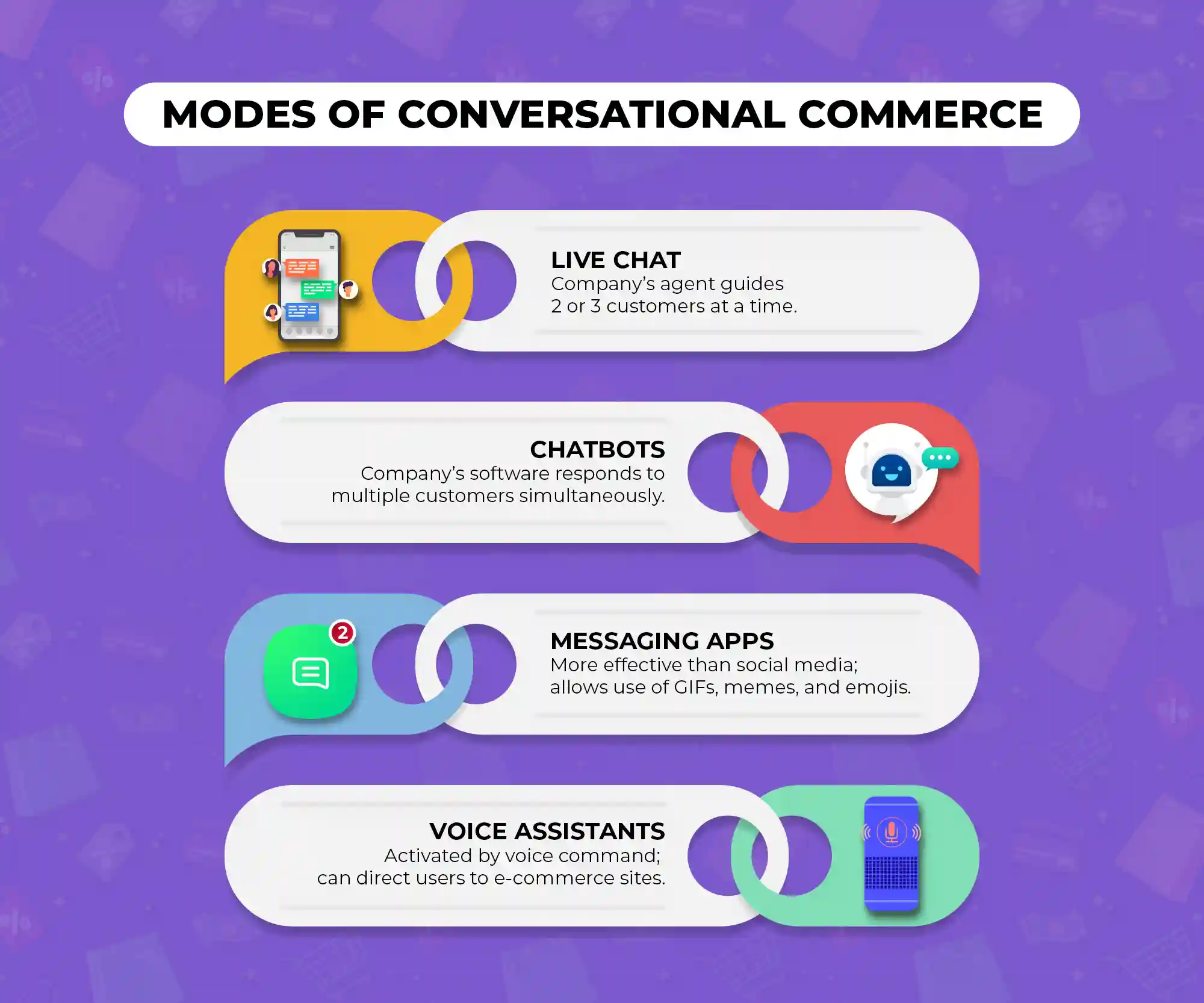
Undoubtedly, the e-commerce industry has flourished since 2020, when digital adoption became the norm. In three years, however, it has evolved drastically from delivering goods and services remotely to creating experiences for virtual customers. One of the biggest challenges for e-commerce leaders is navigating the changing buyer behaviour in this hyper-digital world. Buyers want a less complex and more engaging experience. And as if to one-up the feature of live commerce, the idea of conversational commerce is picking up steam.
What is conversational commerce?
As the name suggests, conversation coupled with buying and selling is known as conversational commerce. Brands utilising AI-powered mechanisms like voice assistants and chatbots to create a channel for conversation with customers is its essence. Conversational commerce helps them develop and nurture relationships with their customers. Nowadays, people spend hours on social media and messaging apps like WhatsApp and Messenger. Through conversational commerce, brands capitalise on this trend by meeting customers inside the messaging apps. Social platforms like Instagram, Facebook, WhatsApp, Telegram, and WeChat have become the hub of the current e-commerce market. Moreover, it has paved the way for businesses to sell their products and services on social platforms through interactive sessions via chats and virtual assistants. Because of this channel, the seller is available to the customers 24*7*365—interacting, receiving feedback and solving queries. And reportedly, that’s what customers want. A Forbes survey revealed that 87% of customers are more likely to return to a brand and continue making purchases if the customer experience, or CX as it is known, is worth it. Conversational commerce has thus elevated CX to a whole new level.
How does AI power conversational commerce?
Conversational AI is the technology that enables machines to interact with humans via language. It’s a subset of Artificial Intelligence and leverages concepts like machine learning and neural networks. Virtual assistants like Siri and Alexa are some successful productions of conversational AI.
The difference between a conversational AI and a chatbot is simple: conversational AI is used to build chatbots. Chatbots are only one channel. However, companies can utilise conversational AI in different media, spoken or written, bringing natural flavour to the ‘machine’ interaction. Thus, the ‘natural’-sounding responses enhance the CX as the AI optimises the dialogue to create a pleasant experience. Amidst rapidly growing competition in the e-commerce market, this could very well be the factor that sets apart a brand. Additionally, cross-selling (adding related products to the customer’s search) and upselling (recommending high-end versions of the customer’s search) becomes more appealing to the buyer.
More and more brands recognise that they can leverage automation capabilities to design workflows. One successful example would be HSBC’s use of conversational AI from last year onwards during its digital transformation. Earlier, clients could only access foreign-exchange-related analytics from their trading software. Now, they can instantly access it while engaging with a chatbot and also get to know the risk factors involved. Thus, AI ensures a heightened level of accuracy by furnishing more metrics for the client’s reference.
What are some tools of conversational commerce?
1. Live Chat Software
This tool is an all-in-one customer service chat software businesses use to deal with customer interaction. It organises your messages and provides custom forms and AI chatbot automation. It can also replace the sometimes-cumbersome email marketing approach. This tool is prevalent in the tax industry and real estate, so FAQs are not merely listed with template responses but are uniquely answered case by case.
2. Drift
Drift is also a game changer as it helps business owners connect with their clients using chat, email, and videos. In addition, it offers the feature of a playbook through which you can maximise opportunities for interaction with the visitors to your website. From setting up a welcome message to walking customers through product demos, the Drift playbooks significantly increase the odds of conversions.
3. Engati
Engati is one such tool known for its humanising customer engagement element. It helps businesses build effective chatbots and provides an easy-to-navigate interface for users.
Furthermore, messaging apps like Facebook Messenger, Telegram, WhatsApp, Instagram DMs, Youtube communities, and Discord servers—all play a crucial role in making conversational commerce functional.

How do businesses benefit from conversational commerce?
Three critical factors of conversational commerce contribute to the success of this new way of marketing.
1. Customer-centric
On average, an internet user spends around 7 hours online per day. Businesses have therefore started to position themselves accordingly. “Be where your customers are” is the mantra here. And given that it allows round-the-clock assistance and intelligently personalised recommendations, conversational commerce is a welcome experience.
2. Omnichannel
Conversational marketing integrates a multichannel approach to provide customers with a seamless shopping experience. Whether you are shopping from your mobile phone or laptop, you can conveniently talk to the brand’s representative on the platform of your choice. Chatbots, for instance, are programmed in a way that they interact with customers visiting both the website and the mobile app.
3. Pre/post-sale support
Conversational commerce merges the benefits of offline self-personalisation and proximity with the online advantages of variety and instantaneous response. Therefore, brands now have happier customers as it is integrated into every step of the customer journey (awareness, consideration, decision, action, retention, and advocacy).
When conversational commerce is in full effect
Many businesses turned lemons into lemonade by switching to conversational commerce during the pandemic. And many, after realising its potential, have joined the race now.
Here are some exceptional results.
Note: These results are based on reports furnished by the respective AI programmes used by the following companies.
1. Nykaa
Renowned beauty brand Nykaa deployed a chat AI in its system to offer customers a smooth and engaging shopping experience. They created a ‘beauty advice’ button in the chat box, connecting customers with beauty experts. These beauty experts handpicked the products, catering to their specific needs. Using the power of artificial intelligence and conversational commerce, Nykaa successfully engaged most of its customers in under a minute.
2. CEAT
One of India’s leading tyre manufacturers, CEAT, is also not behind in the conversational game. It became the first in the industry to deploy a conversational AI in its system, offering personalised customer support through WhatsApp. Whether lead generation or logging and tracking complaints, CEAT has increased its conversion rate through this initiative.
3. CARS24
CARS24, a major player in the used cars sector in India, made over one-third of its monthly sales using WhatsApp chat and AI chatbots. The adoption of this model by Cars24 has made a strong impact due to personalisation.
4. HSBC
Customer chat channels are live on HSBC’s retail side, and they report that customer adoption is “significantly increasing”. The bank is considering chatbots with additional features such as variable tone of voice and customised suggestions by reading into the customer’s financial needs. They expect to handle 10 million chat conversations by 2024.
What is the future?
The total spending on conversational commerce is estimated to reach $290 billion by 2025 from $41 billion in 2021. That’s seven times the growth in just four years.
One thing brands need to remember is not making customers use channels they don’t prefer. It’s a new wave of e-commerce and clubbed with livestream commerce; it can revolutionise the industry and will change emerging markets completely. The future of e-commerce looks exciting as businesses continue to build and design their online platforms keeping mobile commerce in mind. This approach will therefore favour customer experience as a priority.



